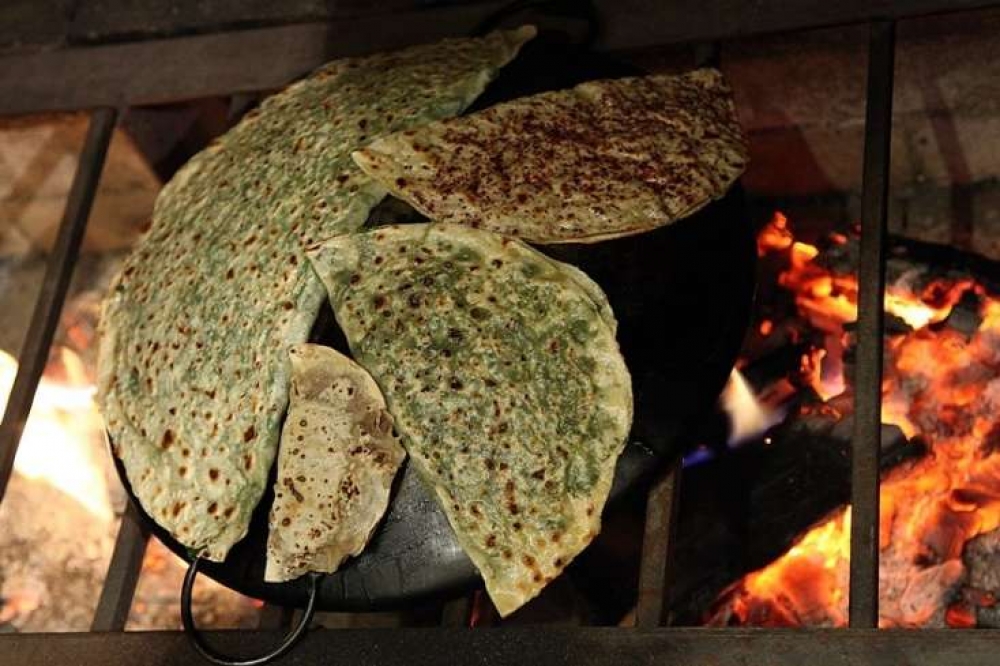ID :
626783
Fri, 04/01/2022 - 18:04
Auther :
Shortlink :
http://m.oananews.org/index.php//node/626783
The shortlink copeid
Karabakh cuisine – 3

Baku, April 1, AZERTAC
One of the main components of the meal of every Azerbaijani is bread. Various types of bread were baked in Karabakh - kullama, bozlamaj, tandir, churak, kozlama, komba (ash-cake), lavash, khamrali, yukha, fatir, galincha, maldili, chapartma, jad and ajitma. In both summer and winter, the favorite kind of bread was yukha, which was thin as paper. It could be stored for years. People took a saj with them when traveling in order to bake yukha. Baked yukha was dried and stacked in a pile. Before use, water was sprinkled on it to make it "fresh". For messengers, it was milled into flour, and they could eat it on the go without dismounting from the horse or quickly prepare it like the Russian "tyuri" by adding water and dried minced meat. Yukha is used to make the traditional sandwiches "durmak" or "burmak". To do this, yukha is stuffed with cheese, cottage cheese, herbs or butter, jam or meat, rolled up as a tube, folding the bottom so that the stuffing does not fall or spill out. The oldest sajs – made of clay – were found in Karabakh during excavations at Uzarliktapa (Aghdam district). They belong to the 4th millennium B.C. Stone and clay sajs were found during archaeological excavations in the entire territory of Azerbaijan. Now iron sajs are used. Sajs are good not just for baking bread and yukha (a kind of flat bread), they are also used to bake jad (corn cakes), kata and gutabs (thin pieces of dough stuffed with meat and other fillings), national pastry products such as fasali, kata and various dishes - sajichi, govurma and jiz-biz. An inverted saj is used as a kind of tava (pan). Unlike other regions, the saj was used in Karabakh to bake "layli yukha" – yukha made of layers: in this case, one side of yukha was prepared on the previous one. This bread could not be stored for a long time, but it was more aromatic and tasty than the usual yukha. If the dough was kneaded with milk adding honey or sugar, "khirt-khirt yukha" (crispy yukha) was made. It was made on holidays and sometimes without the sweet filling. "Lavaş" was made on a saj and tandir. The lavash was mostly cooked in Gubadli, Jabrayil, Zangilan and Fizuli districts of Karabakh. "Komba" of puff pastry was made in a tandir and under a saj, or on ashes. Such flour products as "sudlu chorak" (milk bread), "fasali", "bishi", "yaghli koka", "eyirdek", "keppeche" and "sakkizlik" are common in Karabakh. We would like to dwell separately on the "kata" (flat pie with greens). Kata is made on a saj. To this end, chopped greens and various fillings (with cheese, cottage cheese, potatoes, etc.) are spread on half of a thinly rolled yukha. The other half covers the staffing. The edges of the dough are stuck and baked on both sides on a saj. When it is served, a piece of butter is placed inside and gatig (yogurt) is served alongside. Another type of kata is gutab. It is smaller in size. Gutabs are cooked with herbs, meat, pumpkin, etc. They look like Azerbaijani chebureks (chiy borak, borak with raw meat), but unlike chebureks, they are not fried, but baked without oil. Such products are common to all Turkic peoples. In Turkiye, they are called "ay (lunar) borek", in Borchali - "taycharig" and in Bashkortostan and Tatarstan - "kystybyy".
To be continued





